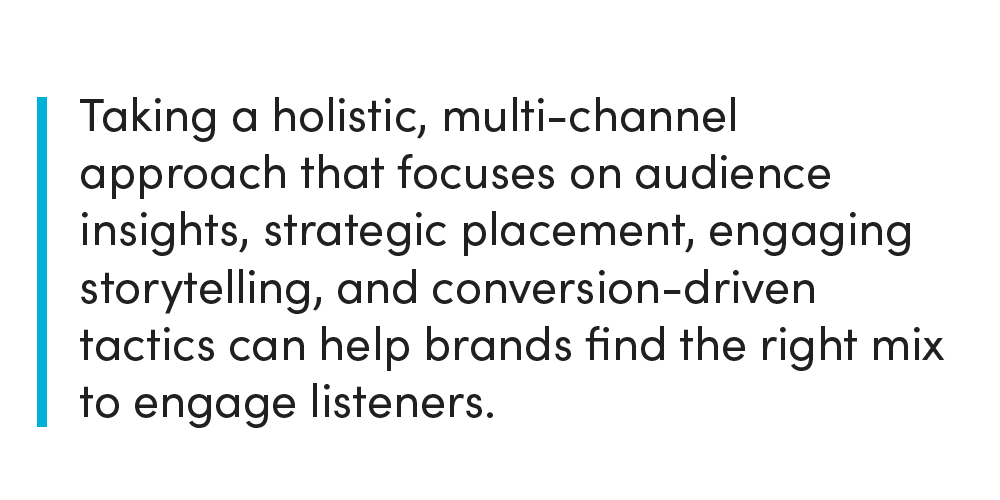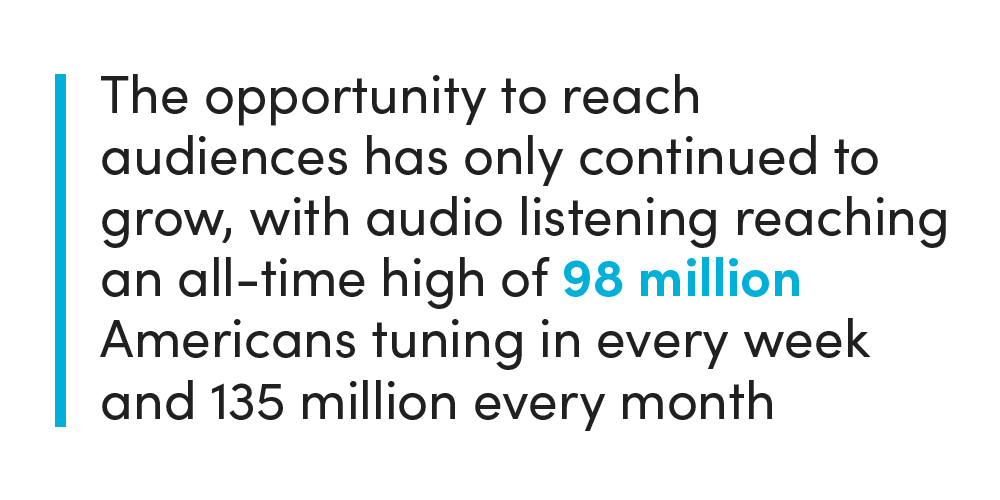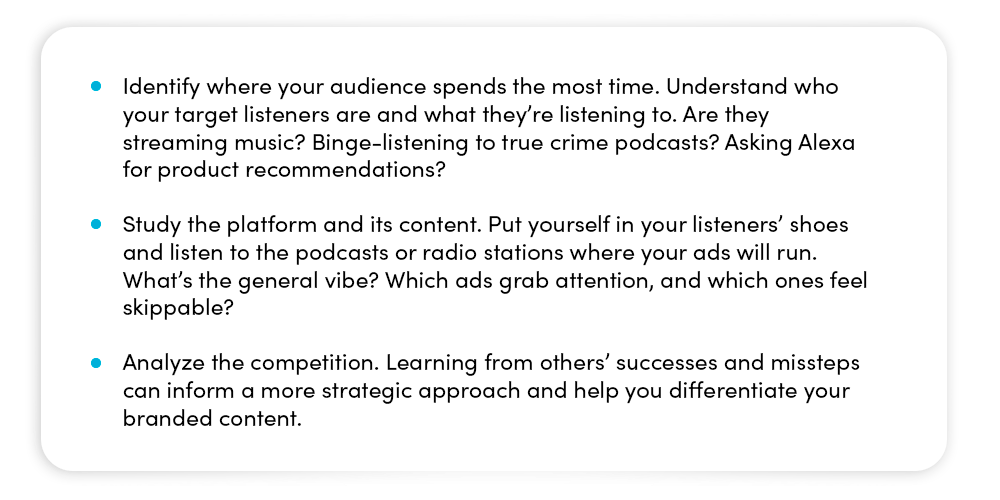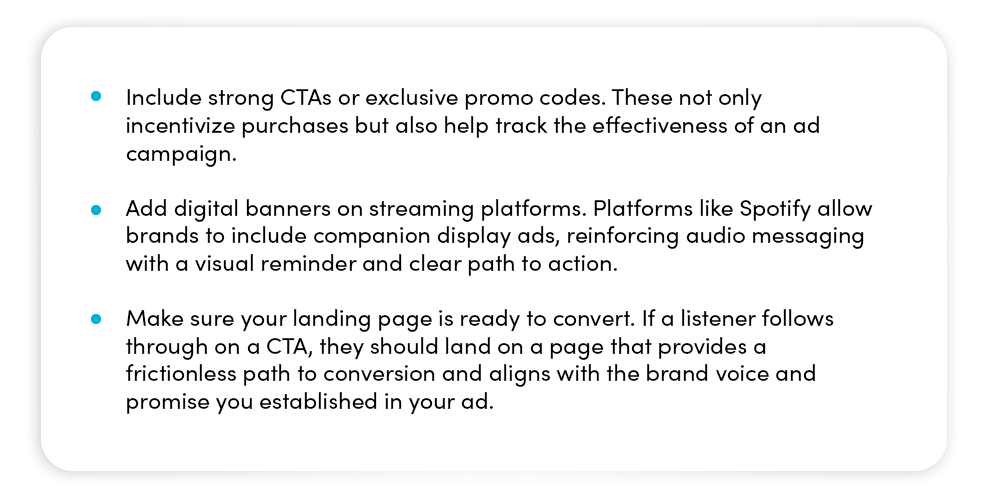Since the first radio ad in 1922, audio marketing has been a powerful tool for reaching and engaging audiences. (How many brand jingles have been collectively stuck in our heads for years?) Now, the audio landscape is even noisier due to the rise of podcasts, music streaming platforms like Spotify and Pandora, and connected devices like Siri and Alexa. And just as the platforms for listening to audio content have evolved and multiplied, so have the methods for advertising across those channels.
Such changes pose opportunities and challenges for savvy marketers who recognize the value of a listening audience. The prevalence of digital audio marketing channels offers advertisers greater variety and more precise audience targeting, but consumers now have more control over their advertising experience than ever, with the ability to skip, mute, or tune out completely. So, how do brands cut through all the static and make sure their message is heard loud and clear?

Audio advertising is a rapidly evolving medium, so it’s also important to measure along the way and take a look at trends over time.
The Auditory Opportunity
Audio marketing certainly isn’t new, but the digital world has added layers since the golden age of radio and has shortened the window for conveying your brand message. Early broadcast radio spots informed general audiences through live reads lasting several minutes, whereas today’s standard streaming audio inventory usually maxes out at 60 seconds. Not to mention, the rise of voice assistants like Siri, Alexa, and Google Assistant has even made audio ads interactive
When the first podcast launched in 2004 and as ad-supported music streaming services gained popularity, brands quickly learned that they could target their advertising more precisely to niche audiences by inserting short, engaging content through pre-, mid-, or post-roll spots. Podcasts have the unique ability to reach a captive audience. According to a study by Acast, a massive 64% of respondents pay full attention to podcasts, compared to 49% of music streamers and 44% of radio listeners.
Studies also show that consumers have higher recall of audio content than other mediums. Commercial jingles have continued to serve as a sticky brand tactic since the early days of radio, and recent research demonstrates that audio ads drive 24% higher recall than display ads. The inherently passive and mobile nature of audio might be a contributing factor to its success, serving as a complement to listeners’ daily routines rather than a disruption.
The opportunity to reach audiences has only continued to grow, with audio listening reaching an all-time high of 98 million Americans tuning in every week and 135 million every month, according to Edison Research. So, the question for brands isn’t whether to invest in audio marketing – it’s how to do it effectively. If you’re exploring ways to add more audio to your brand’s marketing mix, here are a few tips for a successful strategy:
 Keys to success #1: Know Your Audience, Know Your Platform
Keys to success #1: Know Your Audience, Know Your Platform
Just like any other advertising medium, knowing your audience is the foundation of an effective audio strategy.

For brands that don’t have the bandwidth to conduct time-consuming manual research, partnering with an experienced agency, like our team at (amp), can streamline the process. We have successfully placed ads across multiple audio platforms and can
help brands like yours develop a customized, results-driven audio media strategy.
Key to Success #2: Read the Room
Audio is an intimate and immersive medium, making it ideal for storytelling. Audio content – from podcasts to playlists – has the unique ability to create an atmosphere for the listener, so it’s important to ensure your ads align with the atmosphere and don’t disrupt it.
Forced, overly scripted, or out-of-touch messaging can stick out – in a bad way. The best ads feel like a natural extension of the podcast or radio show with conversational and relatable content. Not to mention, a conversational approach can also support brand discovery through voice search that favors natural language and long-tail keywords.
Audio also offers the opportunity to add personality to your branded content, particularly through humor (when the vibes are right – remember: read the room). Listener affinity for podcast hosts or celebrity endorsements increases brand trust and can break the ice for a well-placed joke.
Effective audio advertising requires creativity, and the brands that lean into it are often rewarded, sometimes literally. Even the Webby Awards recognize outstanding podcast ads and branded content, underscoring the power of good humor or engaging stories for connecting with audiences.
Key to Success #3: Optimize for Conversion
Creating an engaging audio ad is just the first step – brands also need to ensure their audio marketing efforts drive measurable results. There are a few ways a great ad can seamlessly guide listeners toward taking action:
 Be Heard in 2025
Be Heard in 2025
As digital audio marketing continues to evolve, brands must balance the science of targeting and placement with the art of storytelling. Those who master both will create powerful, memorable campaigns that resonate with their audience and drive meaningful engagement.
Our team at (amp) understands that all the noise can be overwhelming, but our experts specialize in crafting audio advertising strategies that cut through the clutter and deliver results for brands like yours. Let’s make sure your story is heard – contact us today to get started.